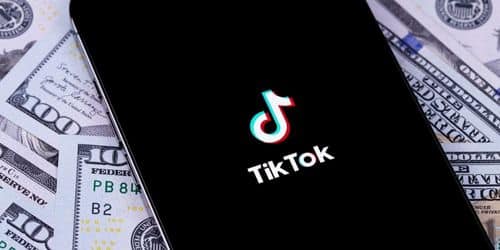So you’re using TikTok and wonder, “How does TikTok make money?” Here is a detailed explanation of their three (3) revenue sources, their various products and services, TikTok’s business models, year-over-year revenue, and how TikTok works.
What is TikTok, and How Does It Work?
TikTok, also known as Douyin in China, is a video-sharing social networking software that allows users to make unique short-form movies such as dance, comedy, and lip-syncing voiceover skits.
It is owned by the Chinese corporation ByteDance, which also purchased the lip-syncing music app Musical.ly in November 2017 for up to $1 billion US dollars.
Since its inception in 2016 and its merger with Musical.ly in 2017, TikTok has gone viral, resulting in the explosive popularity that has followed with its dance videos, comedy, and lip-syncing voiceover skits.
How Does TikTok Make Money?
TikTok generates money through advertising, in-app purchases, and eCommerce offerings. TikTok’s advertising options include In-Feed Ads, Brand Takeover Ads, Top View Ads, Branded Hashtags, and Branded Effects. TikTok in-App Purchases involve people purchasing virtual in-app coins, and Ecommerce offers typically include affiliate money.
Let’s dig into each revenue stream to understand TikTok’s monetization strategy better.
#1. TikTok Ads
TikTok, like every social media network, relies heavily on advertising for revenue. Here are the many types of commercials that advertisers use on TikTok.
1. TikTok In-Feed Ads
In-feed advertising is short video commercials that appear in the user feed as they browse through the “For You Page,” which contains content tailored to the user. This advertising, similar to those seen in Instagram Stories, mixes with the TikTok feed.
2. TikTok Brand Takeover Ads
TikTok Brand Takeover advertising, as the name suggests, takes over the entire screen as soon as users launch the app. These advertisements raise public awareness and promote sales by displaying them to their intended demographic.
3. TikTok Top Views Ads
TikTok Top Views Ads are similar to TikTok Brand Takeover Ads in that they appear in the first In-feed post after 3 seconds, but they do not dominate the screen as soon as users check-in. These full-screen ads with auto-play and sound can run for up to 60 seconds, increasing brand exposure.
4. TikTok-branded hashtag ads
Branded Hashtags advertising on the discovery page encourages consumers to create a video dancing or doing something related to a specific product. Users submit these amusing videos with a specified brand hashtag after generating them. Branded hashtag ads are an excellent format that assists raise awareness while also turning it into a fun game.
5. Branded TikTok Effect Ads
Custom stickers, augmented-reality filters, and lenses are among the Branded Effects that users can add to their films. TikTok allows these effects to remain online for up to 10 days, providing users ample opportunity to interact with the business.
#2. TikTok Coins
TikTok also earns money through virtual coins, which both TikTok and TikTokers can use. TikTok with 1,000 or more followers can earn virtual presents by broadcasting a live video.
If viewers appreciate their material, they can tip them with virtual gifts, but each gift is worth a set amount of coins, which they must purchase with real money through the TikTok app. The coins can then send presents to their favorite content providers.
These coins start at 100 for $1, although pricing is subject to change and may vary by country. Users can use these coins to purchase virtual presents ranging from Panda (5 coins) to Drama Queen (5,000 coins). TikTok receives diamonds as presents from other users.
TikTok charges a 50% commission before transferring the rest of the money to TikToker’s account; therefore, a diamond represents 50% of one coin. So, if a TikTok user has diamonds worth $500, he will receive roughly $250, with the remaining $250 going to TikTok. TikTok can withdraw money once it hits $100 and cannot withdraw more than $1,000 in a single day.
#3. Ecommerce Provisions
One of the significant trends in the social media sphere in recent years has been the facilitation of eCommerce.
TikTok, too, has been working for quite some time on introducing eCommerce-related functionality. TikTok began testing essential retail links within clips in 2019.
TikTok then enhanced its on-platform selling options by introducing live-stream shopping events and a Shopify integration to display product adverts in-stream.
According to Bloomberg, “TikTok has begun working with merchants in markets, including the UK, on methods they can sell things directly to millions of users within the app” in May 2021.
The commercial arrangements of such collaborations are foggy because it is still in the rollout phase. Still, one can infer that TikTok takes a percentage of the sales amount for functioning as an affiliate, as other social media platforms such as Instagram do. Allowing users to make purchases directly within the app lowers the friction associated with moving customers elsewhere and boosts conversion rates that might otherwise suffer.
TikTok Revenue and User Statistics
TikTok is expected to produce $1.9 billion in revenue in 2020, a 457% increase from $350 million in 2019. TikTok generated $4.6 billion in 2021, a 142% increase yearly.
TikTok has 1 billion monthly active users worldwide as of September 2021, representing 22.32% of the 4.48 billion active social media users. TikTok has been downloaded 3 billion times since its introduction in 2016, making it the first app outside of Facebook to accomplish this milestone.
TikTok Investors
Bytedance, TikTok’s parent company that also operates Toutiao, Xigua Video, and BytePlus, was valued at $180 billion after raising $2 billion in December 2020 from US Venture Capital Firm and KKR & Co. Before this round, Bytedance had raised $3 billion in October 2018, $2 billion in August 2017, $1 billion in April 2017, and $5 million in July 2012.
Bytedance was worth roughly $275 billion in 2023.
Who are Tiktok’s Clients?
The platform serves as a social hub for Generation Z. In fact; Gen Z accounts for 60% of TikTok users. TikTok’s primary target demographic is thus Generation Z, the “digital natives” who desire attention and social acceptance.
Furthermore, TikTok users (consumers and creators) flourish on the site since it lets them express their uniqueness and originality.
TikTok, in addition to its consumers, caters to the needs of its other customer segment: advertising. This category makes extensive use of the app since it is significantly more effective than other platforms at building deep audience involvement and endorsement through user-generated content.
What Benefits Does TikTok Offer Its Users?
TikTok is unique among social media platforms in that it is primarily an entertainment platform rather than a lifestyle site, and anybody may become a creator. It provides an appealing value offering to all of its consumer segments.
#1. Users’ Guide
The website allows its users to be themselves rather than pretending to be in a staged atmosphere where people provide an idea of the life they wish they were living. As a result, TikTok is a place where users may have fun, be funny, and experiment with new things.
Regarding consumers, TikTok offers “tailored entertainment content,” which means they will be presented with content they prefer. All of this is accomplished with the assistance of its robust algorithms. As a result, a TikTok user exists in its own content universe. Furthermore, unlike YouTube, where users must select a video from many alternatives, users may view their favorite videos immediately after launching the app and scrolling down to another movie, saving time and energy. The brief length of the videos reflects Gen Z’s lower attention span.
Similarly, for content creators, it gives everyone a chance to be noticed and even renowned, which cannot be said for YouTube or Instagram, where the author creates an audience over months or years. Furthermore, the platform offers a low barrier to entry and innovation, as one does not need to upload unique content to become renowned. Simple videos that follow a trend have the potential to go viral as well. In addition, the platform includes simple augmented reality, movie editing, and music functionalities. Its live streaming function allows content creators to communicate more directly with their audience; the site also allows artists to auction off their wares during these sessions.
As a result of the short time it takes to view and create material on TikTok, it has become a seamless pastime for users.
#2. Engagement Ads
In terms of advertisers, TikTok commercials can result in a significant rise in brand engagement. Through the creator marketplace, businesses can directly engage influencers that suit their target market demographic. Another TikTok aspect that coincides with its high engagement is using “challenges.” This is a direct partnership, unlike other social media sites where a third party controls influencer marketing deals.
TikTok successfully meets the needs of its client group by providing amusement to its customers, social recognition to artists, and a massive engagement rate to advertisers.
How Does Tiktok Work?
A user can immediately begin exploring videos after installing the program. To upload your own video, however, you must first register with an email address, phone number, or a third-party network such as Facebook, Instagram, or Twitter.
After creating a profile, a user can navigate through the app’s numerous parts, which are as follows:
- Home offers two feeds the user can toggle between: Following and For you.
- Discover: It displays videos from a user tagged with a popular hashtag.
- Make a video: This brings up the record screen, from which the user can record a video.
- Inbox: It collects all action on a user’s videos into a single location.
- Profile: This is accessible to the user as well as other users.
Here’s an overview of the primary services TikTok offers its users:
Explore Videos
Videos are crucial to the TikTok experience. As a result, a user can watch unlimited videos, from comedy to gaming to DIY to food, sports, memes, and pets.
For You Section
The “For You” tab of TikTok, which also serves as a homepage, is the first item customers view. Users can view a stream of films tailored to their preferences here, making it easy to find new material and creators. This feed is powered by an artificial intelligence recommendation engine that curates a personalized feed for each user.
This page is followed by the “following” page, which displays videos from persons a user follows. In addition, a set of icons can be accessible on the right side of each TikTok video. The first directs the user to the creator’s profile, where it was initially uploaded. Then there’s a heart, which functions similarly to Instagram’s hearts or likes, and finally, the comments. Following that is a right-pointing arrow for sharing specific TikTok videos to other platforms. Users can also pick “React” under the share option of someone else’s video, where they can shoot their reaction while playing and add their overlay video next to the original video. The final icon is a spinning record, representing the music snippet the user is listening to on TikTok.
Discover Section (magnifying glass symbol next to the home button)
This section lets viewers browse and explore the TikTok community’s diverse content. Popular videos, sound, effects, hashtags, artists, and sponsored content are all included.
Make Videos
Creators are the platform’s heart and soul. When students start filming using the + sign at the bottom of the screen, they are given many tools to customize their films. There are various icons on the screen, including:
- Speed: This allows you to capture the video in slow motion or at high speed.
- Beauty: an AR filter that helps to even out their skin tone and conceal blemishes.
- Filters: This three-circled icon at the bottom of the screen allows users to alter the color filter on the camera.
- Timer: aids in the establishment of an auto-record countdown.
- Sounds: This icon, located in the center of the screen, activates the desired musical overlay or sound effect.
Additionally, creators can participate in –
- Duets: With this function, users can film one video alongside another. It can include genuine collaborations, remixes, spoofs, and so on. Users typically use this function to promote music and communicate with fans.
- Challenges: It’s just making a video using a famous song or hashtag, also known as TikTok Trends. Trending songs and hashtags like #eyelipsface, #dontjudgemechallenge, #bottlecapchallenge, #ButHaveYouSeen, and #fliptheswitch inspire users to try new dancing skills or put their own twist on a topic, increasing their views or followers.
- Users to follow: A user can “follow” a fantastic maker by clicking the symbol with their personal image and a plus sign above the heart button on their video. One can also scan their TikCode to find them, and Tikcode is helpful for businesses or individuals who want to promote their TikTok channel on other websites or in person. Every user’s tikcode may be found on their profile page in the upper right corner with four squares.
Conclusion
TikTok is an app that does its job of entertaining people. The app may have begun purely for the Chinese market, but it has grown to such a global degree of popularity that it can now enable its users to earn money from the app, and TikTok profits from it. If you will, this is a win-win situation. The platform is more than just a social media app; it is also a place for businesses to develop themselves in the digital age. So, while TikTok is at its peak, consider how you will use this chance to introduce your organization to the TikTok community.
- Top Free and Paid Video Editing Software In 2022
- HOW DOES AMAZON MAKE MONEY? The Unique Business Strategy
- HOW DOES INSTAGRAM MAKE MONEY IN 2023
- HOW DOES FACEBOOK MAKE MONEY IN 2023
- Writing a Brand Story the Right Way (Detailed Guide)






